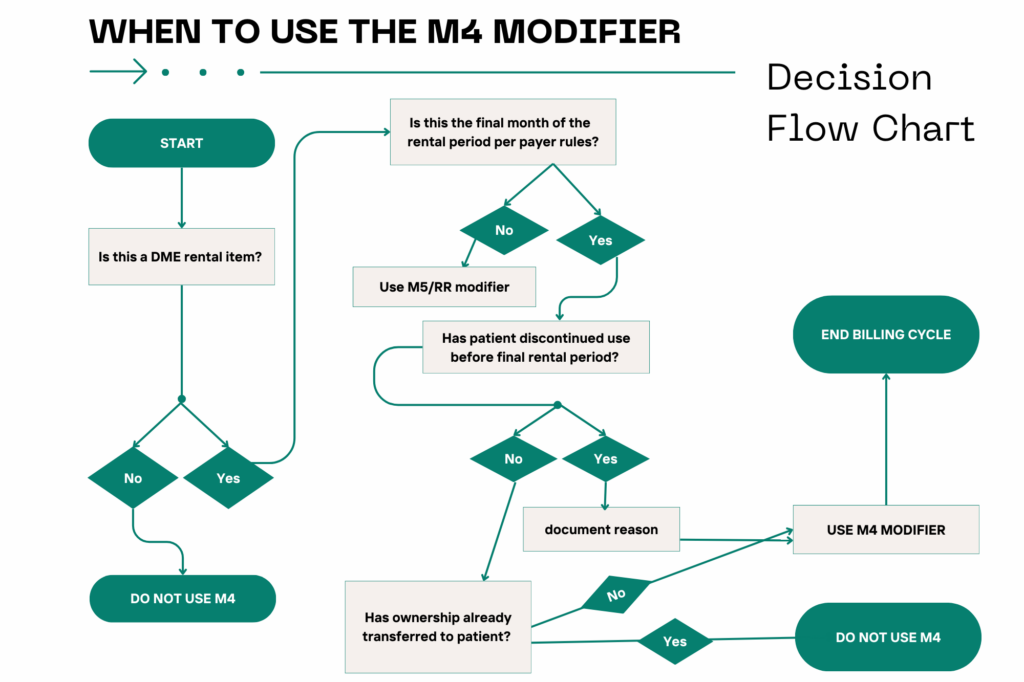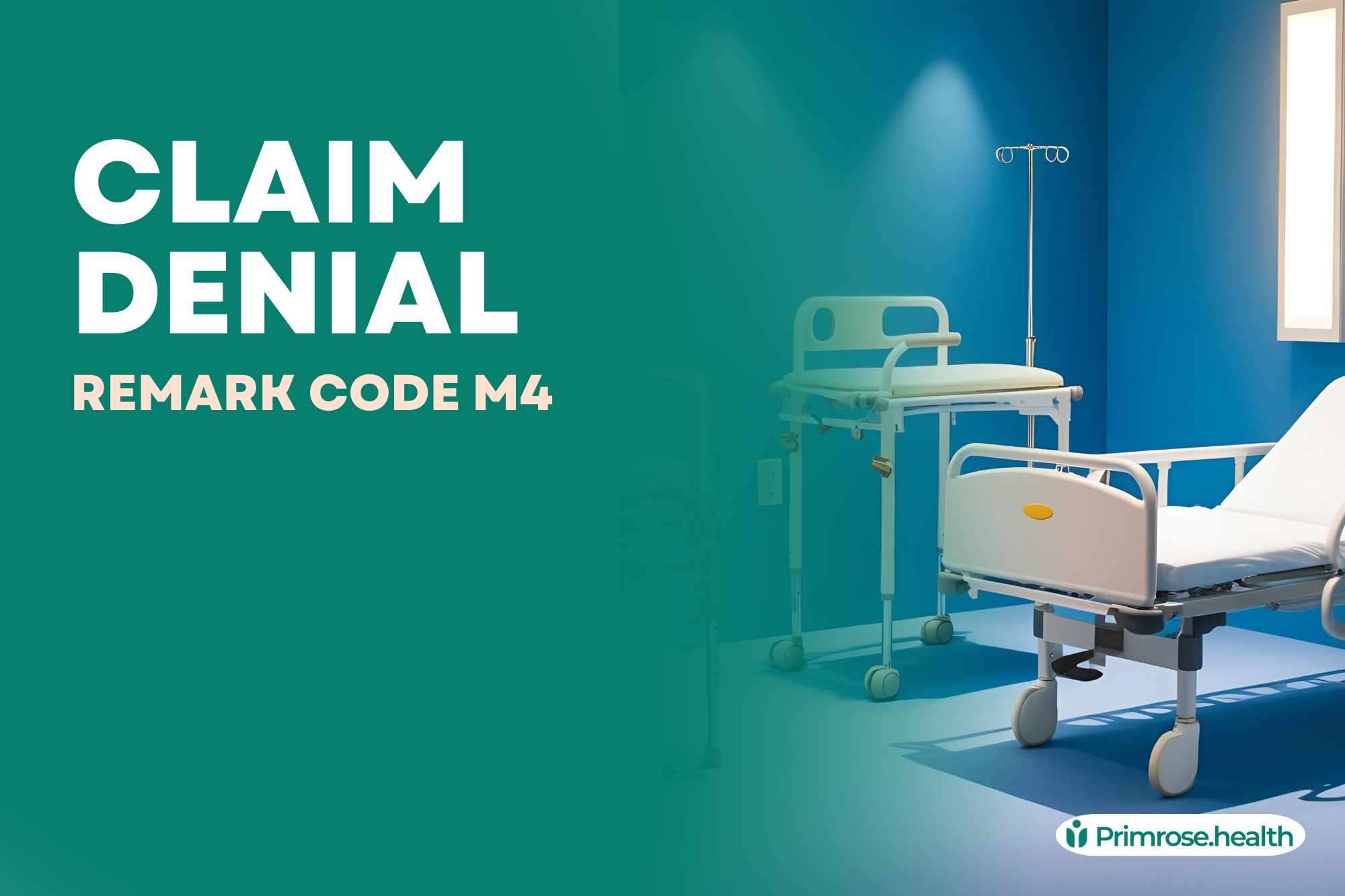Introduction
When a patient leaves the hospital but still needs medical equipment at home, renting it often makes more sense than buying it outright. Items like hospital beds, wheelchairs, CPAP machines, and oxygen concentrators are typically provided on a rental basis, with payments made month by month. For billing teams, keeping track of these monthly rentals is more than just checking boxes. It’s important for getting payments right and avoiding problems during audits. One small code makes a big difference here: the M4 modifier.
This modifier is added to the claim to show that the final rental payment is being billed. It tells the insurance company that this is the last charge for that item. If it’s left out or used the wrong way, it can cause delays or lead to claim rejections.
1. What is the M4 Modifier?
The M4 modifier is a designated billing code utilized in healthcare claims to denote that a provider is submitting the final rental payment for the durable medical equipment. When linked to a procedure code, it conveys to payers that the billing cycle for that equipment has concluded.
Definition: The M4 modifier represents the last monthly rental payment for DME, indicating the end of the billing cycle and often initiating the transfer of ownership to the patient.
Typically, DME rental periods last about 13 to 15 months, in accordance with Medicare’s capped rental program protocols. Nevertheless, the last rental payment may take place sooner if the patient no longer needs the equipment due to alterations in medical condition, insurance coverage, or other factors.
DME Modifier Quick Reference
| Modifier | Description | When to Use |
| M4 | Final rental payment | On the last claim of a rental series |
| M5 | Monthly rental | During ongoing rental periods |
| MS | Maintenance and service | For certain equipment after ownership transfer |
| NU | New equipment purchase | When DME is being purchased new |
| UE | Used equipment purchase | When purchasing previously used DME |
| RR | Rental item | General rental indicator |
When and How to Use M4
Proper timing is crucial when applying the M4 modifier. It should be submitted with the claim for the final rental month after all previous months have been correctly billed with appropriate modifiers.
The process typically follows this sequence:
- During rental months 1 through the penultimate month, claims are submitted with the appropriate rental modifier (often M5 or RR).
- When the final rental payment is due—whether that’s at the standard cap (usually month 13-15) or earlier due to changes in patient need—the claim is submitted with the M4 modifier.
- No further rental claims should be submitted for that same equipment after an M4 claim has been processed.
2. Why M4 Matters in DME Billing
Key Benefits of Proper M4 Usage –
- Creates clear conclusion to billing cycle
- Helps insurance companies manage financial liabilities
- Supports proper claim processing
- Facilitates equipment ownership transfer
- Reduces administrative burdens
- Prevents duplicate or improper payments
3. Billing Challenges and Denials Related to M4
Despite its seemingly straightforward purpose, several challenges can arise when using the M4 modifier:
Challenge | Description | Prevention Strategy |
Incorrect timing | Submitting M4 too early or too late | Implement tracking systems with alerts for rental milestones |
Missing documentation | Lack of records showing rental history | Maintain comprehensive documentation of all rental start/end dates |
Continued billing after M4 | Attempting to bill rentals after final payment | Clear flagging in billing systems once M4 is used |
Mismatch with prior claims | Inconsistent modifier usage in sequence | Regular claim reviews to make sure proper modifier progression |
Payer variations | Different rules among insurance companies | Maintain payer-specific guidelines for reference |
4. Common Equipment Involved
The M4 modifier is typically associated with certain categories of durable medical equipment that are commonly provided on a rental basis:
Hospital beds are among the most frequently rented DME items, particularly for patients recovering from surgery or managing chronic conditions at home. These rentals often follow the standard capped rental timeline.
Wheelchairs, especially motorized or specialized models, represent another category where rentals are common before potential ownership transfer. The complexity and cost of these items make the rental-to-purchase pathway practical for both patients and payers.
CPAP machines for sleep apnea treatment frequently begin as rentals while determining patient compliance and long-term need. Once a patient demonstrates consistent use, the rental period eventually concludes with an M4-modified claim.
Oxygen equipment follows special rental rules under Medicare but still requires proper closure of the billing cycle when the rental period ends. These items highlight the importance of tracking rental periods accurately, as oxygen needs may continue while the billing arrangement changes.
What all these equipment types share is that they’re typically initiated as rentals with an eventual conclusion to the billing period—whether that’s because ownership transfers to the patient, the equipment is no longer needed, or alternative arrangements are made.
5. Example
Case Study: Mr. X’s Wheelchair Rental
Patient Scenario: Mr. X requires a specialized wheelchair following hip replacement surgery.
Timeline:
- January 15, 2024: Rental initiated, first claim submitted with M5 modifier
- February 2024 – February 2025: Monthly claims continue with M5 modifier
- March 2025: 15th month reached, claim submitted with M4 modifier
- Result: Medicare processes final payment, ownership transfers to Mr. X
- Post-M4: No further rental claims submitted; any future services billed as repairs/maintenance
This example demonstrates how the M4 modifier cleanly concludes the billing relationship while facilitating the transfer of ownership, providing clarity for all parties involved.
6. Best Practices for Providers and Billing Teams
To effectively oversee M4 modifiers and DME rental billing:
- Establish comprehensive tracking systems that record rental start dates, prior payments, and expected end dates for each item of equipment. Utilizing either dedicated DME billing software or tailored spreadsheets, having these dates easily accessible aids in avoiding missed or incorrect modifier applications.
- Employ automated notifications or alerts to inform billing personnel when a rental is nearing its final month. These reminders can initiate a review of the patient’s current status and verify that the rental period is truly coming to an end.
- Ensure consistent communication with patients regarding their equipment needs and usage. Alterations in medical condition or equipment performance may necessitate concluding a rental sooner than initially expected, which requires modifications to the billing schedule.
- Regularly assess payer-specific guidelines, as the regulations surrounding rental periods and modifiers may evolve. Medicare’s regulations differ from those of private insurers, and even within private payers, there can be considerable differences in handling DME rentals.
- Thoroughly document any factors that influence rental duration, including changes in patient status, equipment failures, or shifts between care environments. This documentation substantiates the decision to apply the M4 modifier when necessary.
- Perform regular audits of DME claims to uncover trends in denials or problems associated with modifier usage. These examinations can reveal training needs and areas for process enhancements.
7. Common M4 Mistakes and Their Consequences
Mistake | Consequence | Solution |
Billing after M4 is applied | Automatic claim denials | Flag accounts in system after M4 use |
Not informing patients about ownership transfer | Patient confusion about responsibilities | Implement automatic patient notification process |
Inconsistent modifier use across payers | Improper claims and denials | Create payer-specific checklists |
Ignoring M4-related denials | Revenue loss and compliance issues | Regular denial analysis and process improvement |
Missing the appropriate timing for M4 | Disrupted billing cycle | Calendar alerts and proactive monitoring |

Conclusion
The M4 modifier, while being just one small component of the medical billing ecosystem, plays a key role in properly concluding DME rental arrangements. Its correct application assures clean claims processing, appropriate revenue capture, and clear communication between providers, patients, and payers about the status of equipment.
For billing specialists and healthcare providers, mastering the use of this modifier contributes to overall compliance efforts and helps maintain financial integrity. By understanding when to apply M4, how to document supporting information, and how to avoid common pitfalls, billing teams can solve the complex DME rental system more effectively.
As healthcare continues to change, with more care shifting to home settings and equipment needs becoming more complex, proper management of DME rentals—including the final payment indicated by the M4 modifier—will remain an key skill for medical billing professionals.
Need Help With DME Rental Billing?
Managing the complexities of DME rental billing requires expertise and attention to detail. Our billing specialists are well- trained with the knowledge and tools to handle modifier management, assure clean claims submission, and protect your revenue through proper coding practices.
For personalized assistance with your DME billing needs, call us at (205) 880-7575 or visit primrose.health to learn more about our specialized services.
